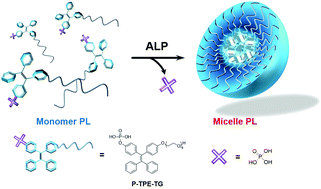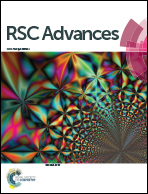A ratiometric fluorescence sensor based on enzymatically activatable micellization of TPE derivatives for quantitative detection of alkaline phosphatase activity in serum†
Abstract
A novel ratiometric fluorescence assay via enzymatically activatable micellization in aqueous solution was devised for quantitative detection of alkaline phosphatase (ALP) activity. We demonstrated that the dephosphorylation of the water-soluble, phosphate-functionalized, fluorophore monomer P-TPE-TG, induced by an enzymatic reaction of ALP, leads to micelle formation in aqueous solution because its water-soluble functionality is reduced. The dephosphorylation-induced micellization of P-TPE-TG exhibited a ratiometric sensing response for various ALP concentrations (10–200 mU mL−1) and provided a suitable sensing platform for naked eye detection with increased fluorescence quantum yield (Φ = 3.2%), even compared to a typical TPE-based sensor (Φ = 1.0%), where ALP can be sensed with a detection limit of 0.034 mU mL−1. In addition, P-TPE-TG displayed excellent sensing performance at concentrations from 0 to 50 mU mL−1 in diluted human serum (10%), which offers the capability to exploit ratiometric responses for bioactive substances under practical conditions.



 Please wait while we load your content...
Please wait while we load your content...